Trip To Ben Tre – Explore The Handicraft Villages In Ben Tre

Ben Tre, in the heart of the Mekong Delta, is cited as the true “kingdom of coconuts”. Nevertheless, a trip to Ben Tre Vietnam is not limited to green landscapes, luxuriant orchards or canals bordered with palm trees. It is also the occasion to discover the handicraft villages in Ben Tre, where traditions and skills are preserved from generation to generation. Whether it is a matter of making red bricks, weaving straw mats or taking a bite of spicy coconut waffles, each visit offers an opening into the local daily life. Autour Asia, a local travel agency in Vietnam, takes you to see the artisans in full growth, pick the coconut yourself, taste the specialties and live at the authentic rhythm of the Mekong.
Table of Contents
- I. Why choose to visit the handicraft villages in Ben Tre ?
- II. The unmissable handicraft villages in Ben Tre, Vietnam
- 1. Handicraft village of coconut candy – Iconic sweetness of Ben Tre
- 2. What to do in Ben Tre ? Handicraft village of brick making
- 3. Handicraft village of coconut fiber of An Thanh – The know-how around the coconut tree
- 4. Village of mat weaving of Nhon Thanh – A traditional art full of colors
- 5. Handicraft village of brooms of My An, Ben Tre
- 6. Handicraft village of Phuoc Long – Handicraft heritage of the Mekong
- III. Practical advice for your visit to the handicraft villages in Ben Tre
I. Why choose to visit the handicraft villages in Ben Tre ?
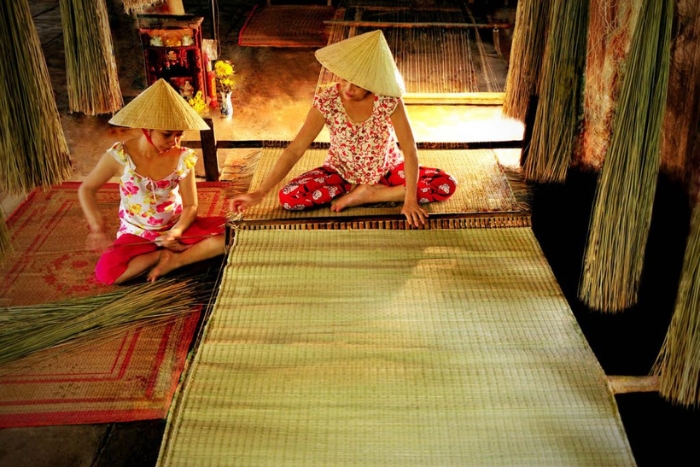
To explore the handicraft villages in Ben Tre is to discover the beating soul of the Mekong delta. Each gesture, each object carries within it an age-old story, transmitted from generation to generation. And you, while going through these workshops, you do not just look: you visit the workshop, you feel the material, talk with the craftsman, take your share of his daily life. For you, it is the occasion to learn how the red bricks, the multicolored rush mats or the coconut sweets of which the locals are so fond are born. By opting for this escape, you also support the local economy and participate in the safeguarding of a unique cultural heritage. Without forgetting that you do not return home empty-handed: around your neck, the memory of a meeting, on your lips, the sweet taste of a coconut and in your mind, the memory of an authentic immersion in the heart of Vietnam.
Since July 2025, the province of Ben Tre has been administratively merged with the neighboring provinces of Tra Vinh and Vinh Long to form a new large province called Vinh Long. Concretely, this means that Ben Tre no longer exists as an independent province on administrative maps, but is from now on part of a larger entity.
> Rest assured: this reform concerns only the administrative organization and has no impact on your trip. The handicraft villages of Ben Tre keep their charm, their traditions and their cultural identity, and they remain essential stops to discover the authentic soul of the Mekong delta.
II. The unmissable handicraft villages in Ben Tre, Vietnam
1. Handicraft village of coconut candy – Iconic sweetness of Ben Tre
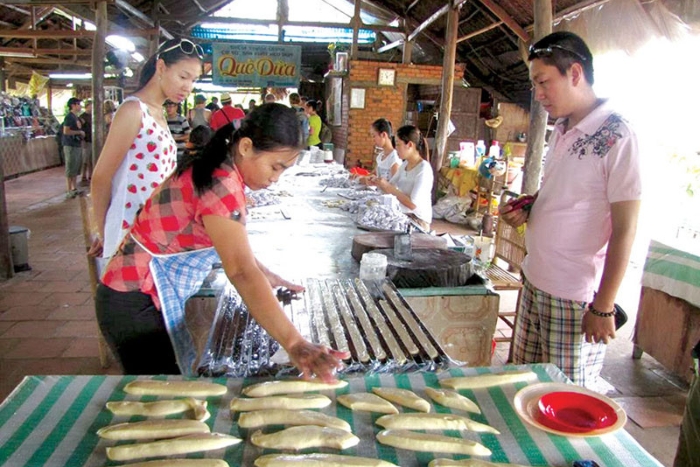
One of the most famous specialties of the region, one can mention the coconut candy. The coconut candy is a sweet preparation with coconut milk, sugar and malt. It is distinguished by a sweet fragrance and its completely melting texture. If you are wondering what to do in Ben Tre, do not miss the opportunity to visit the workshops of making exquisite candies. For each exquisite candy, you will see how the process is carried out, from cooking to packaging. You taste the wild candies that have just been made and even take completely colorful boxes with sugar as a souvenir.
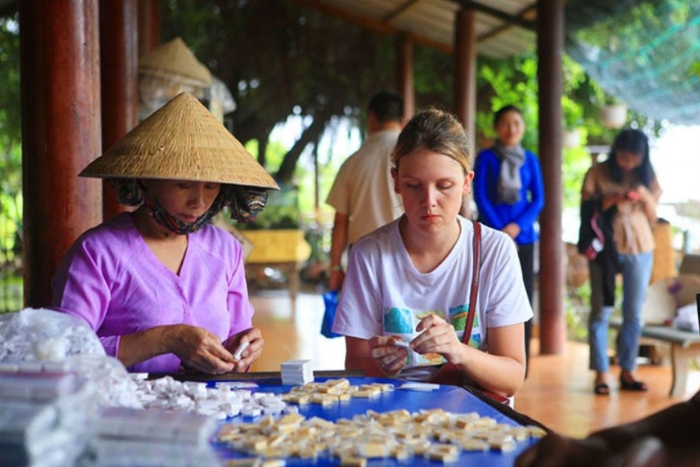
To enter into the handicraft villages in Ben Tre is to discover the sweet world that made the province. Generations after generations, the families of the handicraft villages such as Mo Cay Nam – where the kẹo dừa was born, Mo Cay Bac which shelters many family businesses or Chau Thanh and district 7 (become district of Ben Tre) have even adhered to the art of the transformation of coconut into small melting candy. In the workshops, the smell of caramel from coconut milk is everywhere, one can see the artisans cut the candies still hot and wrap them in colored paper. These villages are not only places of production, but also true witnesses of the local culture, where each bite tells a story of tradition, patience and passion.
Read more: Best things to do in Ben Tre
5 days in Ben Tre
2. What to do in Ben Tre ? Handicraft village of brick making
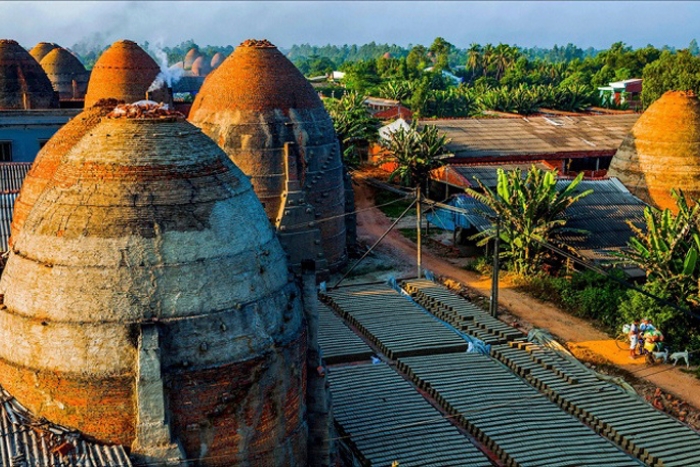
Behind the coconut trees and the coconut candies, Ben Tre possesses another handicraft heritage: the traditional making of bricks. Nourished by the abundance of clay along the rivers and canals, the craft has shaped the identity of the delta for generations. The brick kilns, higher than ten meters, aligned along the rivers and canals, formed a unique red industrial landscape in the Mekong. Even if many kilns no longer function, their production stopped largely because of the disastrous environmental impact and the growing use of modern industrial materials, they remain a silent reminder of the richness of former times and attract more and more travelers in search of the best things to do in Ben Tre.
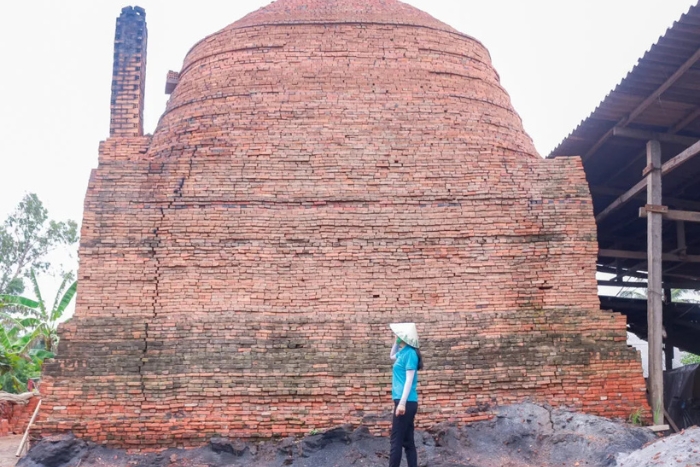
To visit a handicraft village of brick making in Ben Tre is to go back in time. In places such as Phong Nam (today Luong Hoa), Cai Mon (Cho Lach) or even the banks of the Ham Luong river, you can still admire the red kilns covered with moss and imagine the intensity of the work of former days. Certain villages receive from time to time visitors to demonstrate the whole process, beginning with the production of clay, the drying under the sun and the firing of the enormous kilns. It is the travel experience through the handicraft villages of Ben Tre in terms of culture and vision: it is when history, art and daily life of the delta intertwine to create an ideal view.
3. Handicraft village of coconut fiber of An Thanh – The know-how around the coconut tree
- Address: An Thanh commune, Mo Cay Nam district, Ben Tre province (currently Thanh Thoi commune, Vinh Long province)
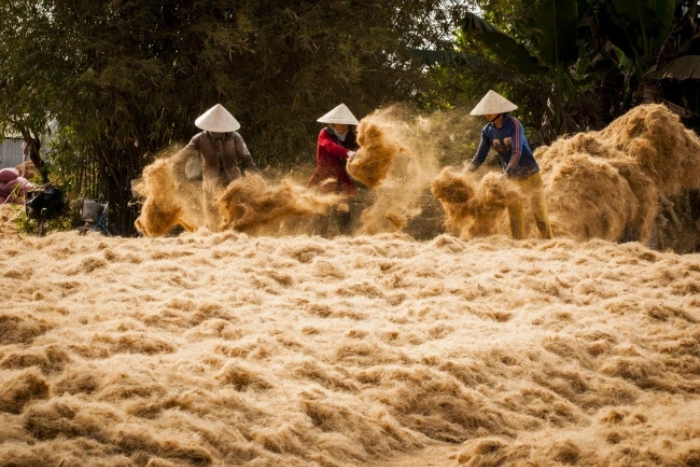
The handicraft village of coconut fiber of An Thanh, former district of Mo Cay Nam, one of the oldest and the most renowned of Ben Tre. Heart of the land of coconut trees, the coconut is not only a fruit to drink or to cook. Recycled into reinforced fiber from its outer shell, it turns out to be a naturally intense material, resistant and entirely biodegradable. An Thanh has used this natural treasure for about two centuries for a variety of articles covering mats, ropes, bags and decorative items, all becoming essential to its culture. What to do in Ben Tre without visiting a village like this one to have an overview of what happens in the Mekong delta.
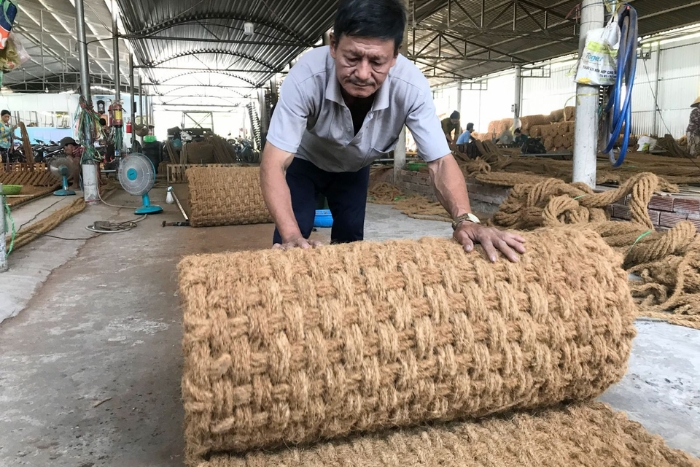
When you visit An Thanh, you will see how this traditional process unfolds; from the husking of the coconut to the drying and the spinning of the fiber. For this, one then hangs the finished product between the straws one another or makes from its original hats and ecological bags. While many products are exported abroad, on the spot you can see how these things will be presented to you and even make something by yourself. It is a very immersive experience, where you can see how the simple coconut shells are transformed into a great number of useful and aesthetic creations, typical of the handicraft villages in Ben Tre and ideal to better understand the local culture when one wants to visit Ben Tre.
4. Village of mat weaving of Nhon Thanh – A traditional art full of colors
- Address: Nhon Thanh commune, Ben Tre city, Ben Tre province (today Phu Khuong district, Vinh Long province)
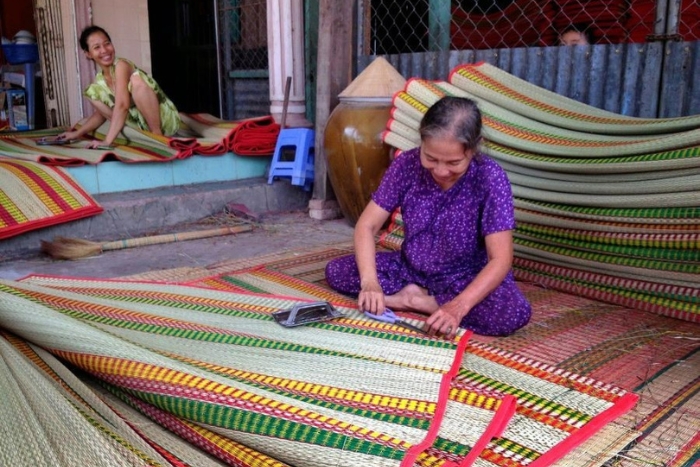
The village of mat weaving of Nhon Thanh is a village located a few kilometers from the former capital of Ben Tre. It is one of the oldest of the whole Mekong delta. For more than one hundred years, the local families have specialized in the weaving of the traditional local mats (chiếu) which were nothing more than some braided reed rushes. Since then, each mat is entirely woven by the human hand, involving dexterity, patience, and insight. However, it is more than simple work. It is a cultural heritage and the identity of the everyday life of Vietnamese culture, an unmissable step for those who wish to explore the handicraft villages in Ben Tre.
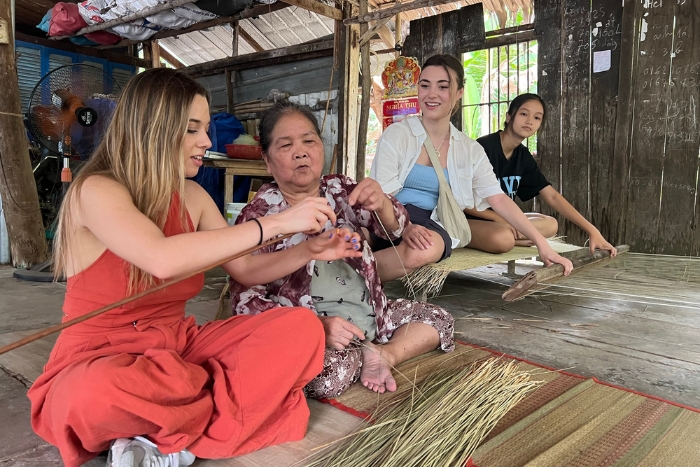
When visiting Nhon Thanh, you will be able to observe each step of the making: the drying and the dyeing of the fibers, the preparation of the loom, then the meticulous weaving mixing colored threads and traditional patterns. The artisans thus transform simple materials into resistant plain mats, flowered mats with colored patterns or even thick mats called “chiếu cặp”, much sought after for their durability. The experience becomes even more immersive when you sit alongside the weavers to try yourself to braid some rows: an authentic moment, at the crossroads of handicraft and culture, and an unmissable step during your trip to Ben Tre.
5. Handicraft village of brooms of My An, Ben Tre
- Address: My An commune, Thanh Phu district, Ben Tre province (today Thanh Phu commune, Vinh Long province)
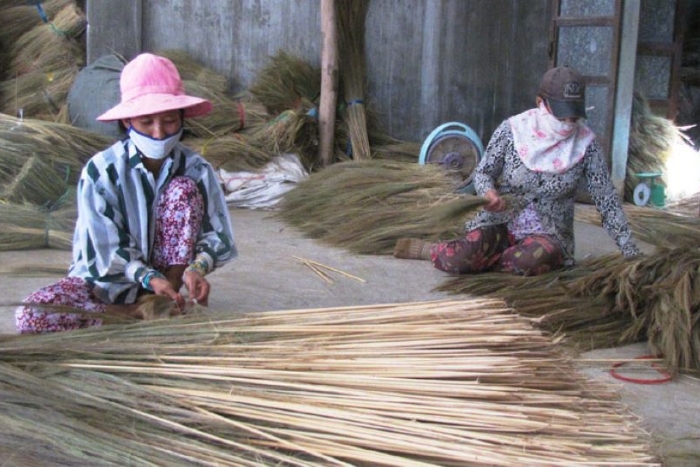
Among the handicraft villages in Ben Tre, in the heart of the commune of My An is found a unique handicraft village where brooms have been made for several decades. Here, almost every household participates in this manual trade: men, women, and sometimes even children, all know how to assemble the coconut stems or the “đót” grasses to create solid and perfectly aligned brooms. This know-how, officially recognized as handicraft village in 2011, is not only a source of stable income for the inhabitants: it also symbolizes the ingenuity and the capacity of the rural populations to take advantage of the abundant natural resources of the land of coconuts.
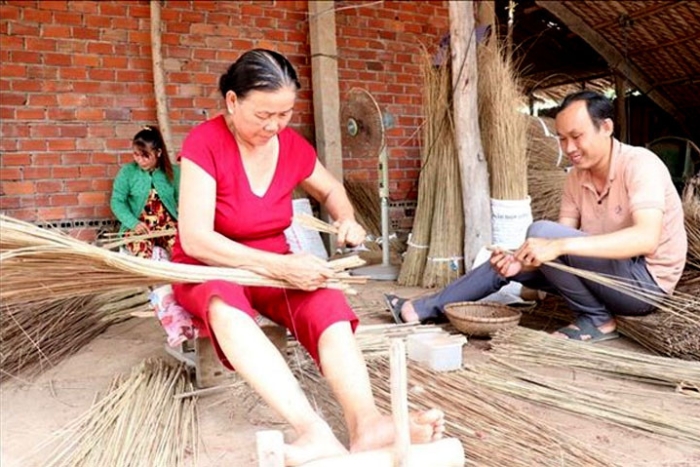
What makes the visit to the village of My An so captivating is the possibility to attend live with a know-how that has remained intact over time. In the family workshops, you follow step by step the process of making: sorting the stems, drying in the sun, precise cutting, then careful assembling and binding. Each step requires great dexterity, and one quickly understands that behind a simple broom hides meticulous handicraft work. The products made are varied – solid coconut fiber brooms, “đót” brooms soft and light, or models with wooden or bamboo handles – and each one reflects the local creativity. The inhabitants, always welcoming, willingly share their know-how and even invite the visitors to try. For those who wonder what to visit in Ben Tre, this experience offers an authentic immersion in the rural life and the daily life of the artisans.
6. Handicraft village of Phuoc Long – Handicraft heritage of the Mekong
- Address: Phuoc Long commune, Giong Trom district, Ben Tre province (today Phuoc Long commune, Vinh Long province)
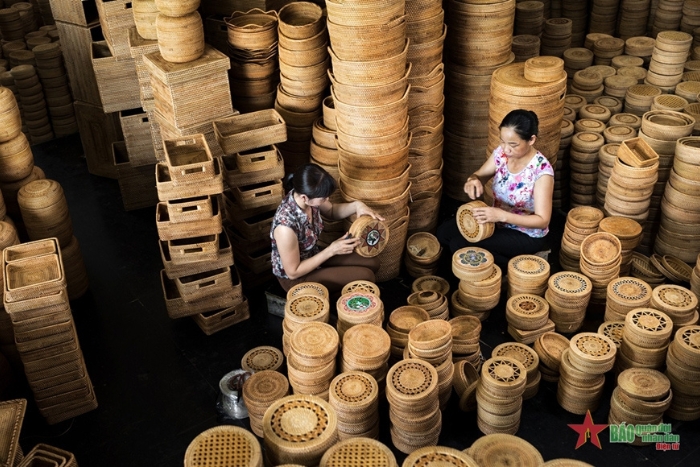
In the heart of the Mekong delta, the handicraft villages are not only the places of production, but also the guardians of cultural memory. One of the most remarkable is the handicraft village of Phuoc Long in the district of Giong Trom, Ben Tre. The village embodies the creative soul, notably the creative thinking and the capacity of the inhabitants of the kingdom of natural coconuts to transform the resources into useful and aesthetically inextricably linked products. This heritage illustrates perfectly the richness of the traditional handicraft in Ben Tre, and moreover, it preserves the rich ancient art which is transmitted from generation to generation.
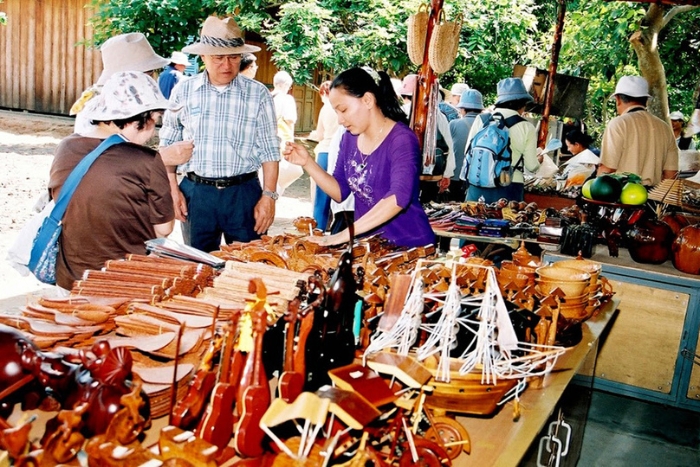
At Phuoc Long, the handicraft revolves mainly around the coconut: shells, fibers and leaves offer the raw material for a wide range of goods. The local workshops offer us decorative objects, baskets, accessories, mats, hats and souvenirs made from poor but lasting materials. While some are made for the local market, others are exported, maintaining the liveliness of the profession. Small and big will discover the process of making, meet the artisans and buy original finished products, ecological and rich of their cultural identities. It is also a beautiful occasion to discover the handicraft villages of Ben Tre, a unique experience of its category to combine with a half-day of immersion in their floating daily world.
III. Practical advice for your visit to the handicraft villages in Ben Tre
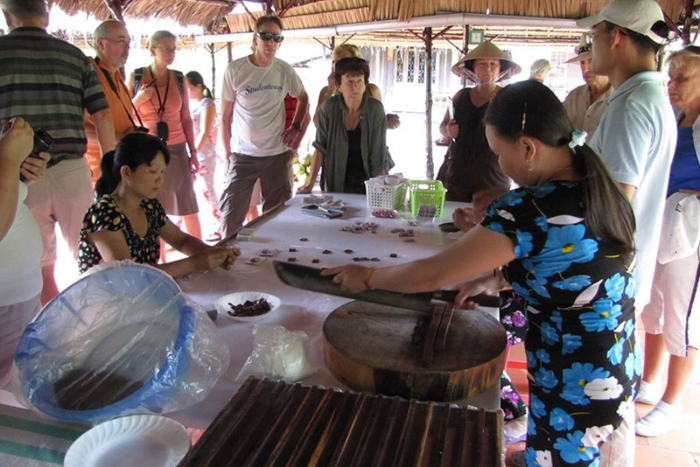
Before closing your discovery of the handicraft villages in Ben Tre, here are some useful recommendations to fully enjoy your stay in the heart of the Mekong delta.
- Best season: favor the dry season from November to April, ideal for walks and visits. But the rainy season (May – October) reveals luxuriant vegetation and greener landscapes.
- Transport: explore the canals by boat to experience the atmosphere of the Mekong, circulate by motorbike if you like freedom, or join an organized excursion from Ho Chi Minh City for more comfort.
- Plan your things: bring a hat, sunscreen, bottle of water and camera – essentials to explore under the sun of the delta.
- Local guide: calling upon a guide allows you to better understand the history of the villages, the handicraft techniques and to listen to anecdotes that only the inhabitants know.
- Ideal duration: count a half-day to visit one or two villages, or a whole day to combine several experiences (coconut candy, mat weaving, bricks…).
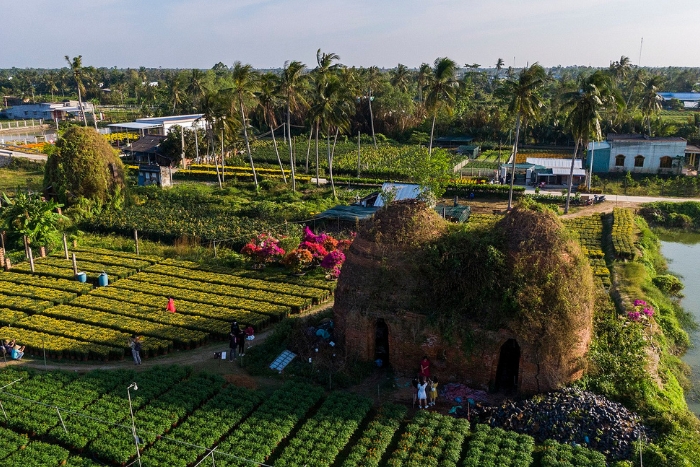
In short, to discover the handicraft villages in Ben Tre is not only a tourist experience. It is a part of the soul of all the localities of the Mekong delta. Each craftsman encountered or each product made manually tells a story: that of tradition, of creativity, of local pride. Whether you attend the making of coconut candies, whether you try the weaving of a colorful mat or whether you admire the old brick kilns: what you experience is not a know-how but an art of living. If you are wondering what to do in Ben Tre, let yourself be guided by these unique experiences. With Autour Asia, you will be able to live these moments of sharing as close as possible to the inhabitants and leave with much more than material souvenirs: a deep link with the culture and the daily life of this generous land.
Learn more:
- Ben Tre Can Tho 3 days trip
- Ben Tre Travel Guide
- 8 days in Southern Vietnam Tour
- South Vietnam Tours
Spending 8 days in Southern Vietnam allows you to enjoy a balanced mix of culture, nature, and relaxation. Start in Ho Chi Minh City, where you can wander bustling streets, discover historic sites, and savor its dynamic cuisine. Continue your journey to the Mekong Delta with a sampan cruise through the canals of Ben Tre for an authentic taste of local life, before heading to Can Tho to experience the famous Cai Rang Floating Market. End your trip with a peaceful retreat on the stunning beaches of Ninh Thuan, ideal for swimming, relaxing, and admiring the coastal landscapes. This route offers a memorable combination of urban energy, cultural immersion, and seaside serenity.
If you have only 2 days in Ben Tre, you will still have the opportunity to live memorable moments. On the first day, leave from Ho Chi Minh City and embark on a sampan ride along the calm canals of the Mekong, in order to discover the authentic rhythm of local life. Take the opportunity to visit some handicraft villages and taste the emblematic coconut specialties. The next day, head towards the district of Giong Trom: stroll through a traditional market, observe the daily bustle and immerse yourself in the unique atmosphere of the delta. In two days, these activities make a beautiful introduction to the warm soul of Ben Tre.
The best season for a trip to Ben Tre extends from November to April, during the dry season. The climate is sunny, pleasant and with little rain, which makes boat rides and outdoor visits easier. It is also the ideal period to explore the handicraft villages in Ben Tre, observe the work of the artisans and take part in interactive workshops without being disturbed by bad weather. However, the rainy season (May–October) can also offer a more authentic atmosphere, with luxuriant vegetation and green landscapes typical of the Mekong delta.
Related travel guide
Other similar articles
CUSTOMIZABLE BY LOCAL EXPERTS
Personalized trip at the original price!
REFUND GUARANTEE
We believe in our work and promise to give you money back.
GOOD PRICE / QUALITY
95% satisfied more than expected!
24/7 LOCAL SUPPORT
We are always available online to provide assistance at any time.
Most read articles
Autour Asia is highly recommended on
Embracing the mission of "Satisfied more than expected" and providing authentic experiences, we have received numerous recommendations on reputable travel forums:























